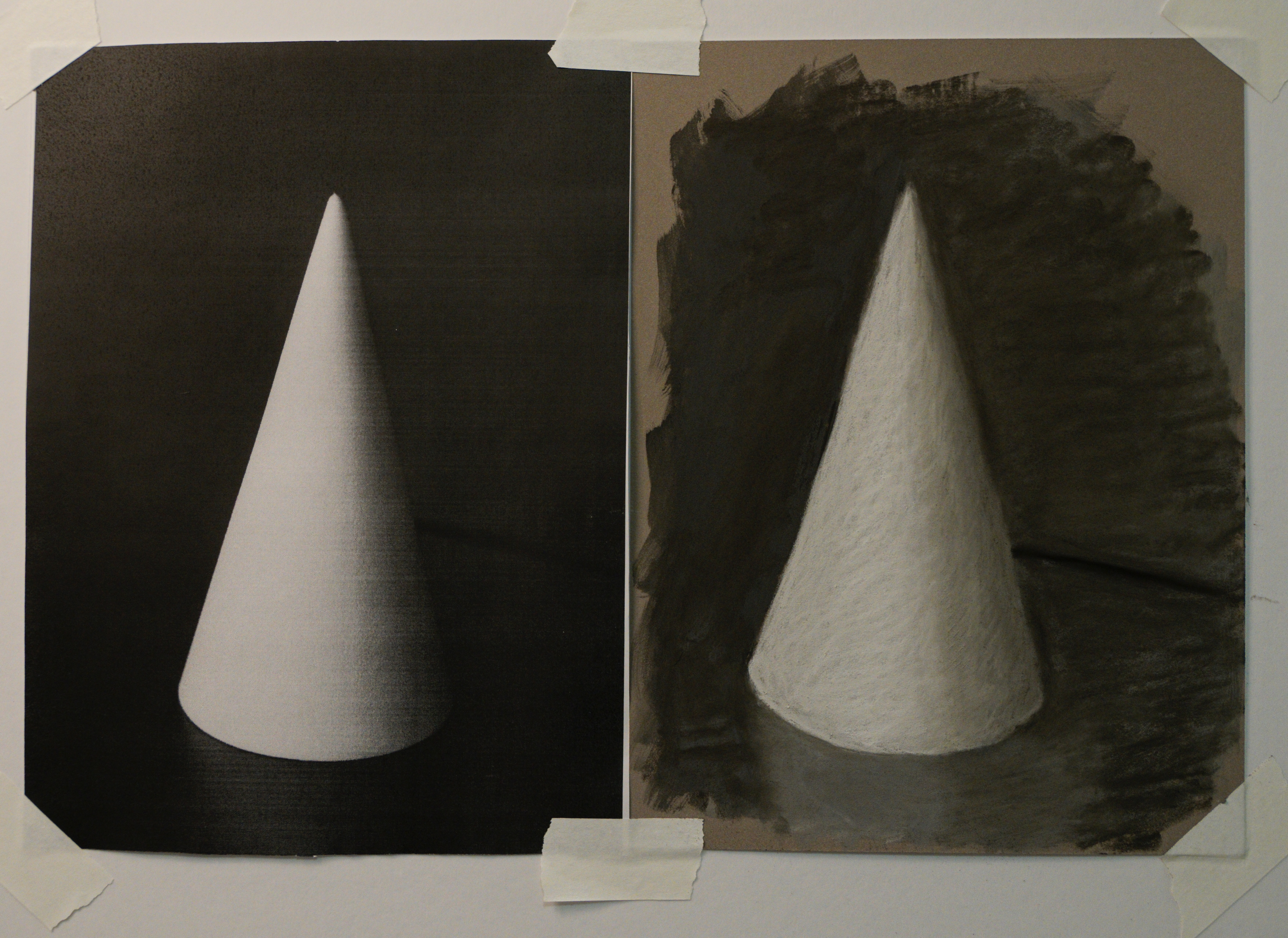
Painting From Memory Experiment
Painting From Memory Experiment
When most people learn to draw it follows one of a few different styles:
- Sight-sized where you place the paper (picture plane) next to the subject, then stand far away such that you can view the subject and paper as if they're next to each other. You then basically plot out copying points from the subject to the paper, and since they're at the same orientation and layout, you can see your mistakes easily. This method does a good job of making an accurate drawing, but is tedious and requires a lot of space. It does work very well for landscape painting though, since the scene is always so far away in a landscape you don't really have to walk back to do sight-sized.
- Relative measurement or "measuring" where you pick a part of your subject to be the "unit of measure", then use that unit to measure the location and size of other objects in the scene. If you were doing a room, you might pick the width of a door as your "one" (aka unit of measure). Then you'd use that "one" to find out how wide or tall other objects in the room were, and where they were located. This method works well and also lets you hold your paper or painting next to you or in your hands. You can also just use a pencil and some paper and that's it. With sight-sized you need an easel and some other things since you have to walk away from it over and over again. The down side is this method isn't as accurate as the others.
- Relative angle or "block-in" This is where you use the relationship of angles to other angles in big chunky blocks to locate and size objects in the scene. Rather than picking the width of a door to find the width of a wall, you'd make a big loose line, then use that line to locate another angle, then that angle to find the edge of a wall, and eventually you've got the general location of the big shapes because you've lined up their angles to each other. This creates an integrated drawing, but it has problems when you want to paint because you have to do a lot of erasing and refining. You can't just draw the 4 things in the scene. You draw 4 big shapes, then "carve" into those shapes, and then erase, and then carve more, then find inside shapes, and carve those, etc.
- Shapes or "painterly" This is where, rather than find the outlines of objects in a scene, you just paint their shapes. It works more with paint than with pencil, but you start with painting about 3-6 big shapes, then you refine those shapes down with more shapes inside. It's called "painterly" because it produces an image that doesn't look obviously drawn, and more direct. Down side is it's pretty difficult to get right in the beginning, and definitely hard to get super realistic with this style.
I actually use all three of these depending on what I'm trying to paint or draw. I find sight-sized is awesome for landscape painting when you need to be accurate. I find I mix measuring and block-in styles when I paint. I'll use angles and measurement to locate edges and objects, then shapes. Many times I also just like to use a painterly approach, but I'll still lay down some guide lines to figure out where things are in a scene. One trick to make a painting look "painterly" but still do drawing is to draw the scene, but then use giant shapes that wipe out the lines, then paint into those shapes. When I use a palette knife I'm almost exclusively using the painterly style, and actually I enjoy that style the most.
Memory Drawing
While investigating these different methods I stumbled on a French guy named Père Lecoq from the 1848 who taught people to paint and draw from memory. He did this as an experiment with children going to the French Academic painting system to see if having them memorize the elements of drawing and painting would make them as accurate as other methods of teaching. At the end of the experiment, several students were evaluated and determined that they did in fact draw as well as other students.
Lecoq eventually got fired or quit from the Academy and went on to simply teach on his own, but he did write a small book on how he taught. I read it, and it was a little confusing, so I found this other book by Darren R. Rousar called . In Darren's book, he goes through the history of memory drawing, and then has a bunch of exercises that attempt to teach it. I read his book, and did about 20% of the exercises and loved how it felt. It was so weird and different from other ways of drawing.
It seems impossible, but you can actually stare at a scene or a photo, and after about 2-3 minutes of staring at it, do a fairly close approximation of it. There's really no way to describe what is happening, but, when I do it I'm not really ticking off a list of points and measurements. I'm staring at what I want to memorize, and periodically closing my eyes, or drawing in the air over it with my pinky, and then staring with "loose" eyes over the whole scene, and then...I can remember what is where and draw it. I really can't explain it.
And, you'd think I'd be way off on my first try, but not really. I'm fairly close on most of the basic shapes I'll show you here. More complex things obviously will be less accurate, but in general I'd say I'm not any more or less accurate in my first to fourth basic blockins than with any of the other methods I listed above. Eventually I'll obviously be more accurate with those methods over the long run, but I'm actually not so sure about that.
You see, the process of drawing is actually one of refinement from a gross mistake. You start off with a guess that's unrefined and messy or bulky. Then you correct that and refine it, and repeat this refinement until you have the level of accuracy you want. After years of studying what I found is that accuracy is more a product of time spent refining than any sort of immediate magical accuracy. 99.9% of all artists who paint or draw very accurately either copy photos, start of with fairly messy guesses that become accurate, or don't actually draw as accurately as you think they do.
Gross Refinement
This got me thinking: What if I could adjust the Lecoq/Rouser memory drawing style to instead use this gradual refinement process. In Rouser's and Lecoq's book the flaw I saw is that they expected me to be able to memory an entire human head with fine gradations of tone and draw it in a few attempts. However, that's completely unrealistic and not how most artists work.
This week I decided to try an experiment where I used my memory to draw some simple in different orientations. I was going to try each of the above processes to see what worked, and also try a few different mediums (charcoal, pastel, oil paint). My goal was to see, could I use my memory only to get a basic drawing, but use the block-in and refinement process that seems to work best.
When you see these though, keep in mind that I've been practicing and training in drawing and painting for a while. Don't think that I'm saying someone with zero art experience could plunk down these shapes and bang out these paintings from memory. There is something strange going on that I can't quite explain, but rather than explain it I'm just going to try to figure out how to do it by doing it a whole lot.
The process I used is basically this:
- Stare at the scene or the photo for 2 minutes.
- Cover the scene or photo and then, looking only at the painting, put down the big shapes I remember.
- Remove the cover and then check how accurate I am. Anything that I get wrong, either I'll erase/wipe it for the next round, or if it's tiny and a small fix will help, just do that small correction.
- Now cover the drawing or painting and repeat #1, but memorizing a smaller part for refinement, or some area I got very wrong.
The idea is I'm attempting to utilize "memory chunking" where, rather than magically memorize an entire photo, I'm memorizing big chunks of the scene. Then, once I have those drawn I dive into the shapes to memorize smaller aspects of it.
The Results
My first experiment was with an actual object in a dark box I use for cast studies (it's actually just a black bookshelf). I did this one in charcoal and white chalk, and used more of a relative measure style of drawing it. I memorized some of the basic measurements of the big shapes using the width of the right side of the block, and also memorized the general shape of the whole scene. This took me about 6 rounds to get to here. One problem though is using a actual object rather than a photo makes it difficult to check my accuracy. I mean, sure, that looks like a rectangle block, but it's difficult to really see if I was dead accurate with it.
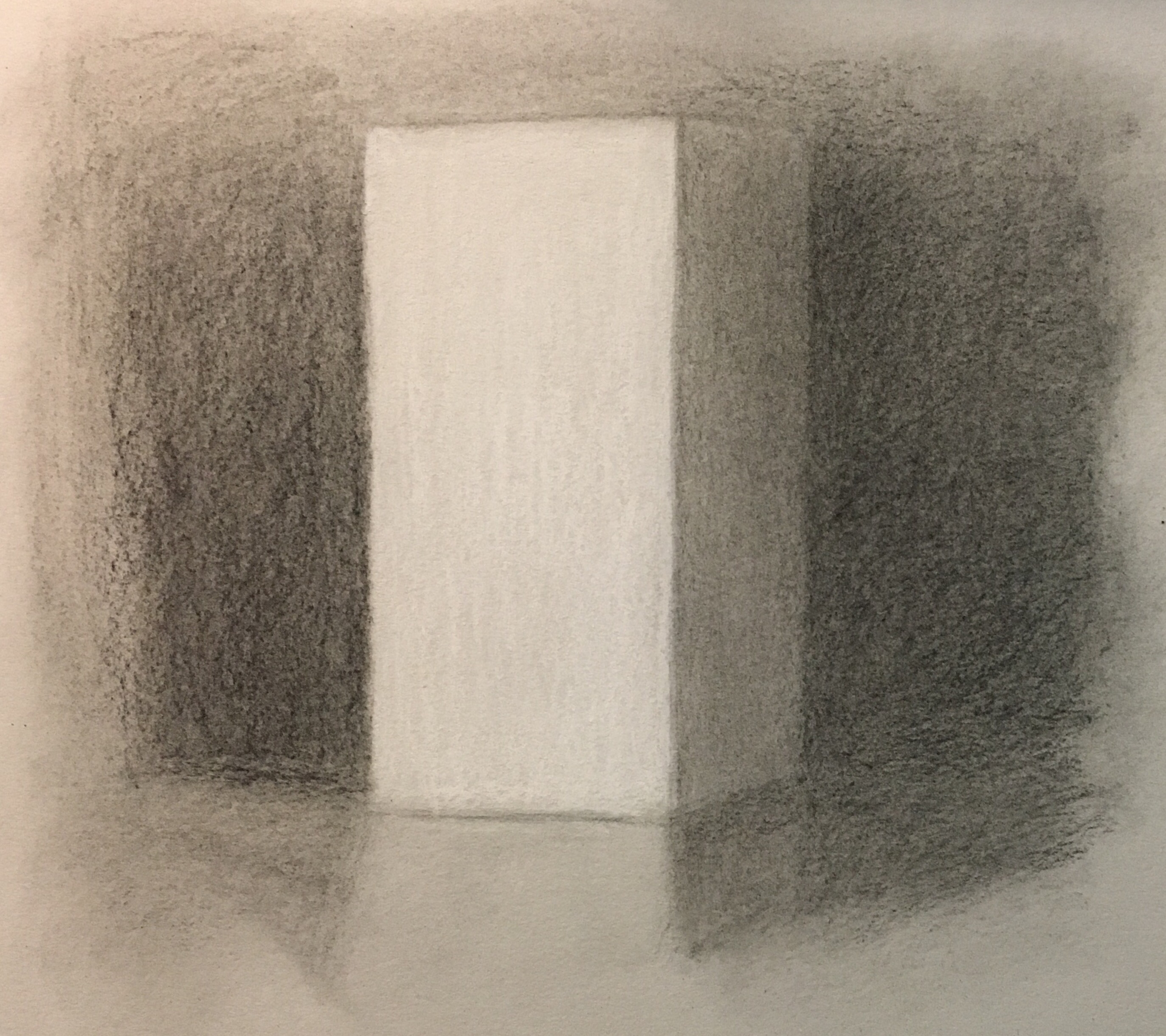
My next attempt I switched to using a monochrome photo printed out, and using pastels. The photo makes it much easier to tell if I'm being accurate or not, and the pastels makes it much quicker to lay down the shapes I'm attempting to hold in my head. Pastels also have the advantage that I have to grab actual values of black vs. white. With charcoal I'm using the paper is a white, and then different amounts of charcoal to get different values. Pastel I grab a white, or a gray, or an almost black, and when I put it down, that's the actual thing I see. This makes it much easier to paint what's in my memory since it's more direct.
I did this in about another 7 rounds, and I used the block-in style of drawing then painting it. First I remembered relatively what the angles of the scene were, drew them from memory, then I memorized what values (white vs. black) when where. This worked pretty well and the pastels definitely are better than charcoal.
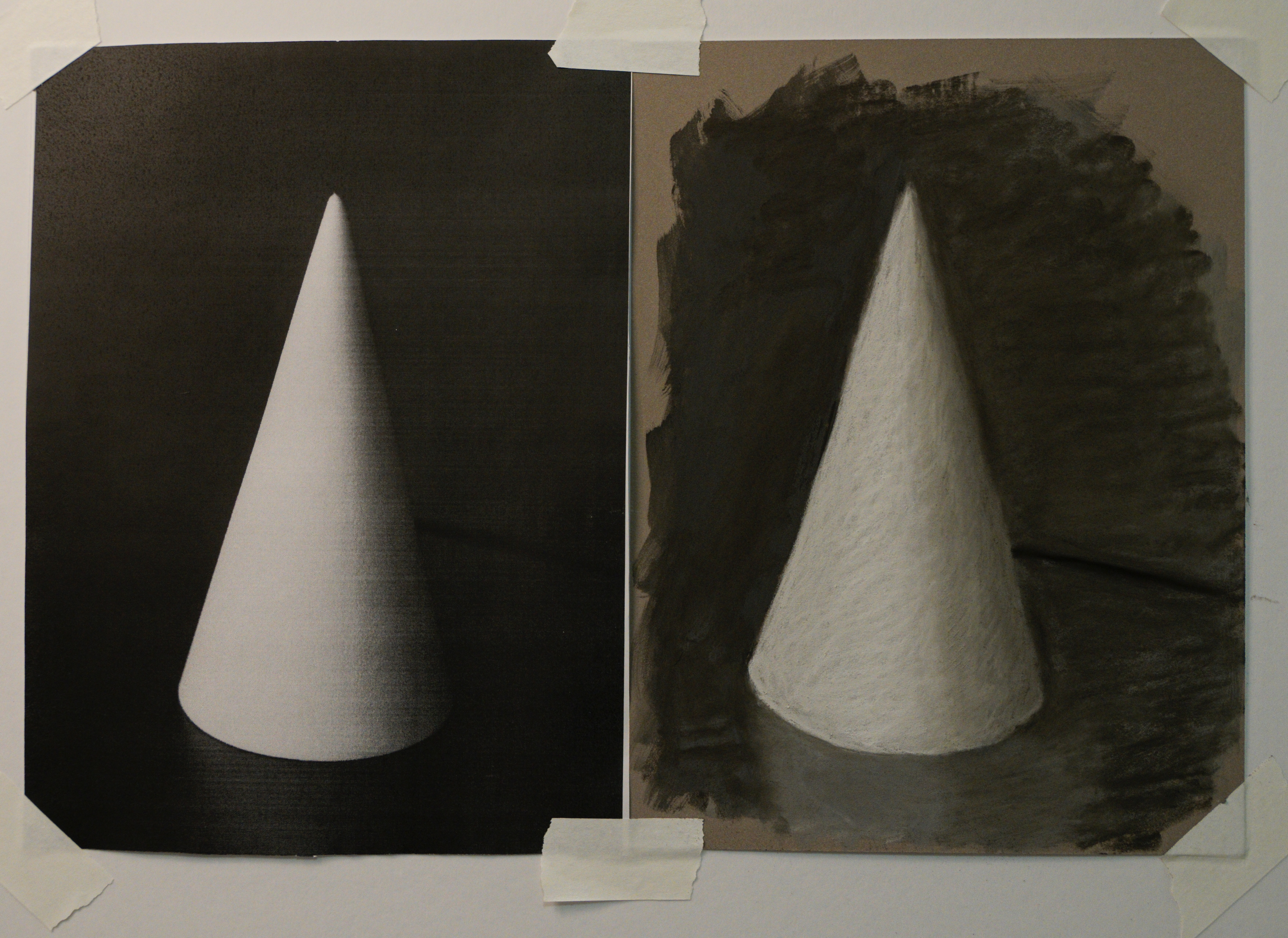
Next I used oil paint, and still from photos, plus stayed with he block-in style of drawing. The oil paint was definitely quicker, and I think I did this in maybe 4 rounds? Next time I'll track how many rounds and how many corrections I made. With the oil paint it was very important to pre-mix the colors so I could work with them like I did the pastels. I think having to mix would take up too much time and wash out any memory of the scene I had. The oil paint definitely went faster, but I could see that for the purpose of checking accuracy it might not be as good as pastels. I will say that I did this very fast before going out to eat, so I'm surprised it was as close as it is.
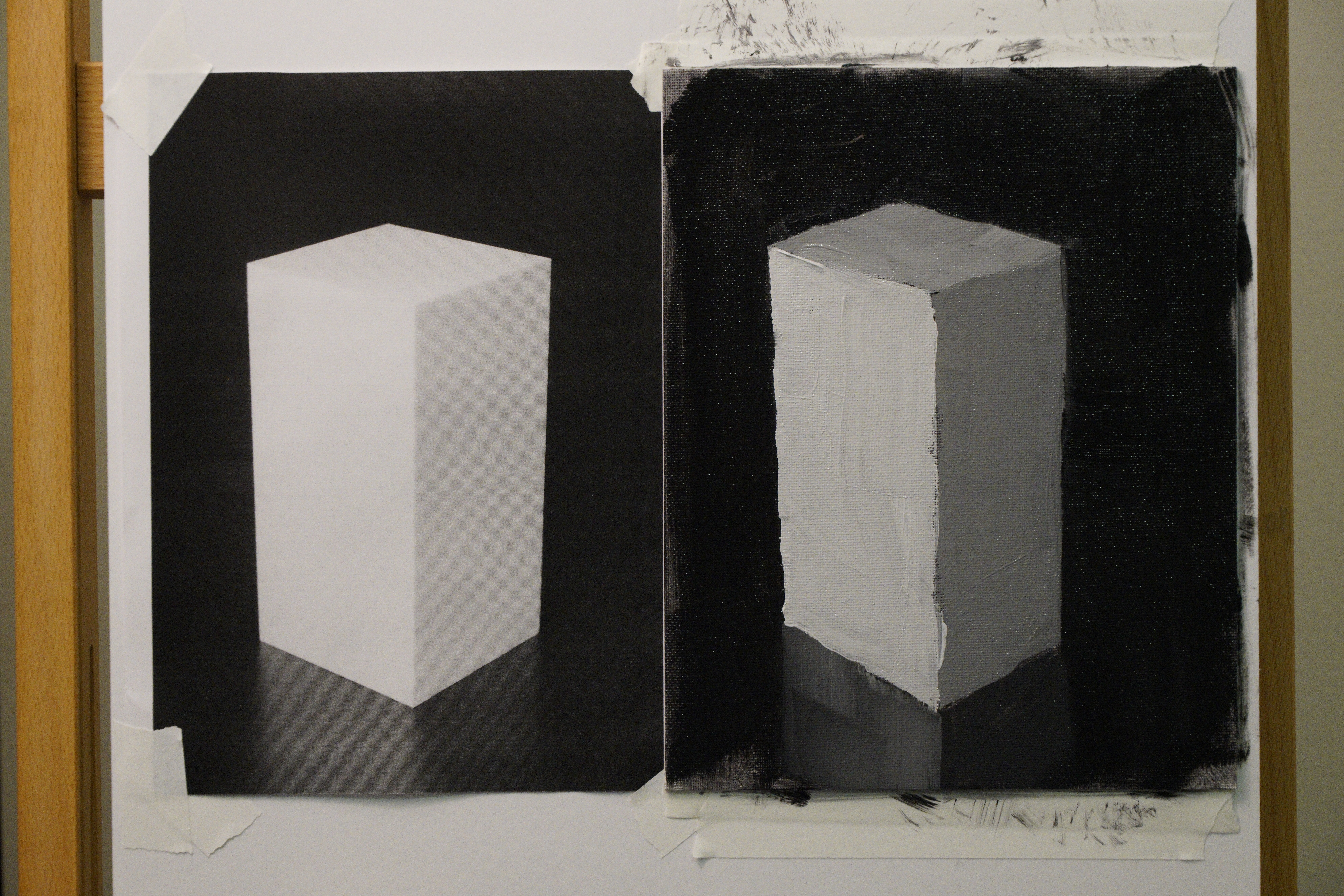
My final test was again with oil paint, but using the painterly method. This shape is challenging because of the ellipses involved, but the painterly approach worked in general. I first memorized the big shape of the dark background and the ellipse. That basically leaves the front of the cylinder so no need to memorize that. I then painted that in really sloppy to get a general idea of where it all goes and the shape. Surprisingly I was pretty close, and on the next round had the cylinder close enough to refine it and render it better on each round. I'd say it's not quite as accurate as the oil painting above, so I'm leaning toward using the block-in method to get a general idea of the drawing, then painterly to block it in and refine it.
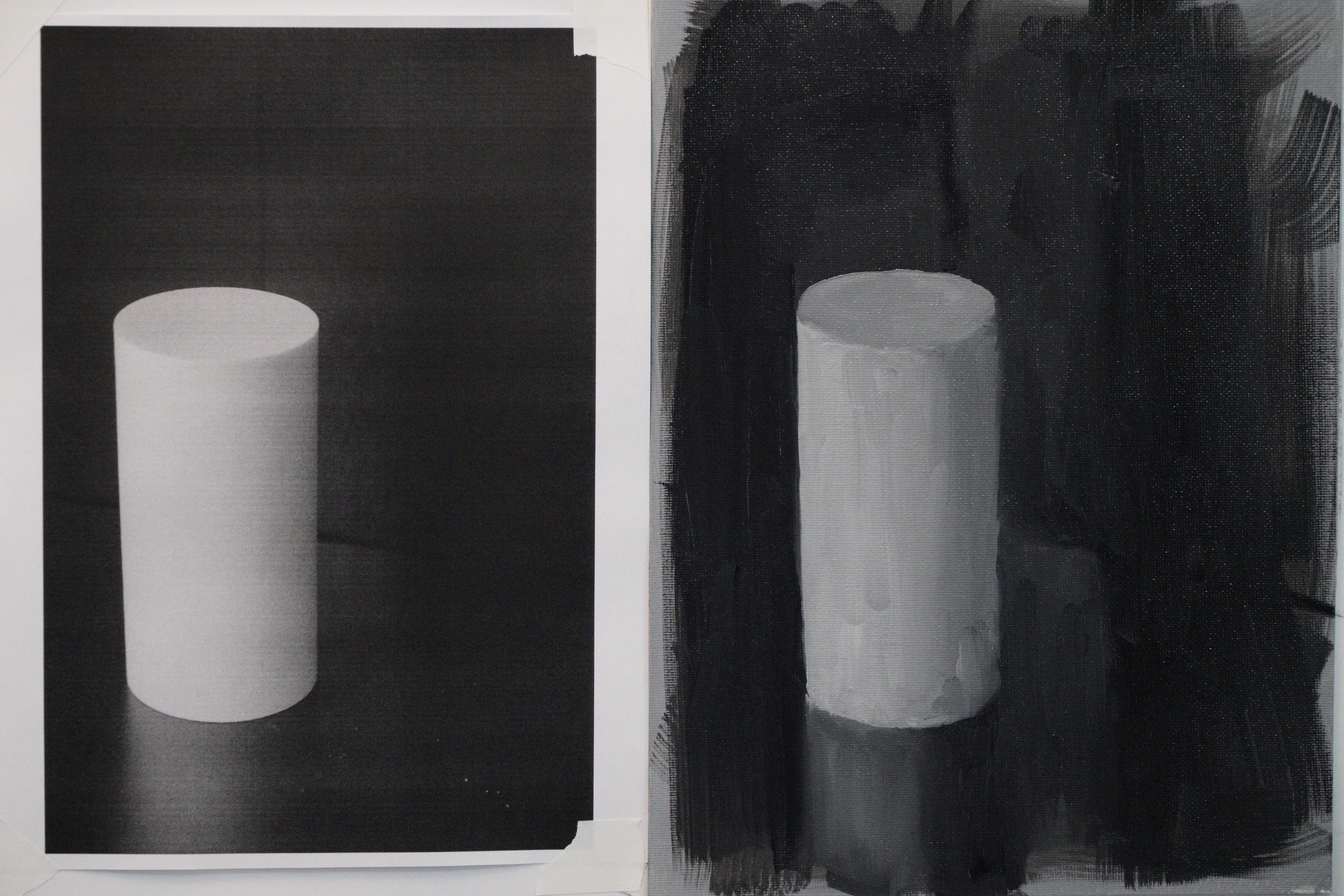
Surprises
I'd say the most surprising thing is that it works at all and that I was fairly accurate on the first and second round. In the case of the pastel painting my drawing was pretty close on the first round. These are simple geometric shapes, but keep in mind I'm copying them from a strange angle with perspective and comparing it to a photo. If most things are based on these basic geometric shapes then I'm thinking I could keep practicing this and eventually get to combining them in more complex ways.
The other thing that is surprising is how easy it was compared to constantly looking and measuring. There was some measuring and comparing when I made little adjustments, but overall I just stared at the photo, covered it, and got pretty close. With regular drawing it's a constant battle of bouncing back and forth to get the drawing right and I might get a more accurate results eventually, but I'm also doing hundreds of "rounds" in that case.
The ellipse in the last painting is a good example of this difference. Normally doing an ellipse is difficult, but in this I kind of just whipped that out with a couple brush strokes, then on the next round altered its value some or refined it a bit. It's obviously not perfect, but pretty good for just a couple of attempts at it. I think with normal drawing I'd work on that for quite a while.
The final surprise so far is how it felt. Doing it this way felt...meditative. I had to stop and slow down and stare at this photo or object until it melted away and turned into a group of shapes. I had to focus my attention, but also not really focus at all and just let it come into my mind's eye. It was nearly the same sensation as meditation, and then when I went to paint it was like releasing a breath. As if what I memorized had to come out now. When I paint or draw other ways it's more like I'm pulling and working a large rope to pull the drawing onto the canvas.
I'll continue this experiment with more complex topics and see how this goes. I'm going to narrow down on the block-in/painterly method, but I'll still bounce between pastels and oil until I'm more confident which one is easier to work with doing this.
More from Zed A. Shaw
The Beggar Barons
The rise of the trillionaire beggars.
Sometimes, It's Fun to Die
The survival crafting video game is my pandemic theme song.
The Most Zed Story About a Knife
A microcosm story that more completely explains who I am than anything else you'll read.
Authoritarianism of Code
An essay on the pervasive internalized authoritarianism found in the programming profession.